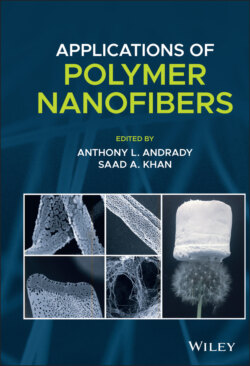Читать книгу Applications of Polymer Nanofibers - Группа авторов - Страница 21
1.4.3.2 Conductivity
ОглавлениеSolution conductivity is required for transfer of electric charge from the electrode to polymer solution (Andrady 2008; Ramakrishna 2005). Solvents commonly used in electrospinning have conductivity lower than water, but they play an important role in solution conductivity. For example, Uyar and coworker observed that the grade and supplier of the solvent affected solution conductivity. Solutions with a higher conductivity produced bead‐free fibers at lower polymer concentrations (Uyar and Besenbacher 2008). Polymer solutions generally have higher conductivity due to conducting ionic species (typically impurities or additives) from the polymer. Increasing polymer concentration can reduce its conductivity. With polyelectrolytes, i.e. polymers that have ionic functionalities, the solution conductivity is highly concentration‐dependent (Andrady 2008). The conductivity of the spinning solution can be increased using additives (Andrady 2008; Ramakrishna 2005). Typically, additives are inorganic salts such as sodium chloride. Organic compounds such as pyridinium formate or trialkylbenzyl ammonium chloride have also been used. Typically, additive concentrations below 2 wt% are used because at high salt concentrations, maintaining surface charge on the droplet becomes increasingly difficult. For example, aqueous solutions of poly(ethylene oxide) and CaCl2 with conductivities above 5 mS/cm could not be electrospun (Andrady 2008).
The additives increase surface charge density maintained on the jet which promotes fiber extension during whipping that can reduce beading in systems (Andrady 2008). In some cases, increased fiber extension can reduce resulting nanofiber size. The size of the conducting species is an important consideration. Ions with smaller ionic radius are thought to be more mobile and create elongational force during electrospinning. For example, solutions containing NaCl had smaller diameter than solutions with dissolved KH2PO4 or NaH2PO4 (Ramakrishna 2005). However, increasing fiber diameter with increasing solution conductivity has also been observed (Mit‐uppatham et al. 2004; Seo et al. 2009). The increases in size were salt concentration‐dependent. For example, increasing the NaCl concentration from 0.1% to 2.0% (w/v) increased the fiber diameter from ~75 to 200 nm (Arayanarakul et al. 2006). The increase in the fiber diameters has been attributed to the increased electrostatic force acting on a jet segment that either delays the occurrence of the bending instability or increases the mass throughput (Arayanarakul et al. 2006). However, it is difficult to isolate the effect of conductivity because the additive also often changes the surface tension, viscosity, and dielectric constant (Andrady 2008). Therefore, observed changes cannot be uniquely attributed to changes in conductivity.
